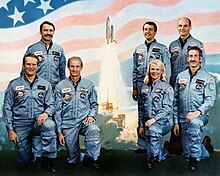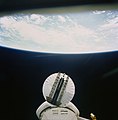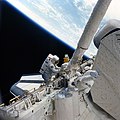|
STS-51-D
STS-51-D was the 16th flight of NASA's Space Shuttle program, and the fourth flight of Space Shuttle Discovery.[2] The launch of STS-51-D from Kennedy Space Center (KSC), Florida, on April 12, 1985, was delayed by 55 minutes, after a boat strayed into the restricted Solid Rocket Booster (SRB) recovery zone. STS-51-D was the third shuttle mission to be extended. On April 19, 1985, after a week-long flight, Discovery conducted the fifth shuttle landing at KSC. The shuttle suffered extensive brake damage and a ruptured tire during landing. This forced shuttle landings to be done at Edwards Air Force Base, California for the next five years until the development and implementation of nose wheel steering made landings at KSC more feasible. Crew
Spacewalk
Crew seat assignments
Mission summaryDuring STS-51-D, the shuttle crew deployed two communications satellites: Telesat-I (Anik C1) and Syncom IV-3 (also known as Leasat-3); both were Hughes-built satellites. Telesat-I was attached to a Payload Assist Module (PAM-D) motor and successfully deployed. Syncom IV-3, however, failed to initiate antenna deployment and spin-up, or ignite its perigee kick motor upon deployment. The mission was consequently extended by two days to ensure that the satellite's spacecraft sequencer start lever was in its proper position. Griggs and Hoffman performed an unscheduled Extravehicular Activity (EVA) to attach homemade "Flyswatter" devices to the shuttle's Remote Manipulator System (Canadarm). Seddon then engaged the satellite's start lever using the RMS, but again the post-deployment sequence did not begin.[4] The satellite was subsequently retrieved, repaired and successfully redeployed during the STS-51-I mission later that year. Discovery's other mission payloads included the Continuous Flow Electrophoresis System III (CFES-III), which was flying for sixth time; two Shuttle Student Involvement Program (SSIP) experiments; the American Flight Echo-cardiograph (AFE); two Getaway specials (GASs); a set of Phase Partitioning Experiments (PPE); an astronomical photography verification test; various medical experiments; and "Toys in Space", an informal study of the behavior of simple toys in a microgravity environment, with the results being made available to school students upon the shuttle's return.[5] Discovery landed on Runway 33 of the Shuttle Landing Facility at Kennedy Space Center at 13:54:28 UTC (8:54:28 am EST local time at the landing site). As the orbiter approached the runway, it was buffeted by a 10-mile-per-hour (16 km/h; 8.7 kn) crosswind from the right, which pushed the orbiter 19 feet (5.8 m) left of the runway's center line as the rear landing gear touched down. As the orbiter rolled out, the crosswind continued to push it towards the left, causing it to drift 65 feet (20 m) from the center line of the 300-foot-wide (91 m) runway. At this point, Commander Bobko began to counteract the drift by applying more pressure to the right-wheel brakes, a technique called differential steering, which brought the orbiter back to the center of the runway. However, he had to apply twice as much force to the right brakes and about 134 feet (41 m) before stopping the brakes on the right-side inboard tire locked up and 5 feet (1.5 m) before stopping the brakes on the right-side outboard tire locked up and the inboard tire blew. The incident prompted NASA to add nose wheel steering to the orbiters, which was complete by late 1985.[6] Until that work was completed, NASA would land the orbiters at the Edwards Air Force Base which offered the option of landing on a long and wide dry lake bed from more directions. Nose wheel steering was also implemented shortly before the Challenger disaster, which would ground the shuttle program for a time. Ultimately, it would be five years until a mission would again land at the SLF, when STS-38 had to divert there due to bad weather at Edwards. Wake-up callsNASA began a tradition of playing music to astronauts during the Project Gemini, and first used music to wake up a flight crew during Apollo 15. Each track is specially chosen, often by the astronauts' families, and usually has a special meaning to an individual member of the crew, or is applicable to their daily activities.[7]
Gallery
See alsoReferences
External linksWikimedia Commons has media related to STS-51-D.
|
|||||||||||||||||||||||||||||||||||||||||||||||||||||||||||||||||||||||||||||||||||||||||||||||||||||||||||||||||||||||||||||||||||||||||||||||||







